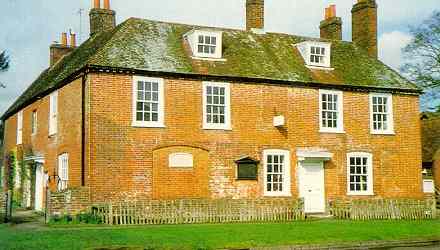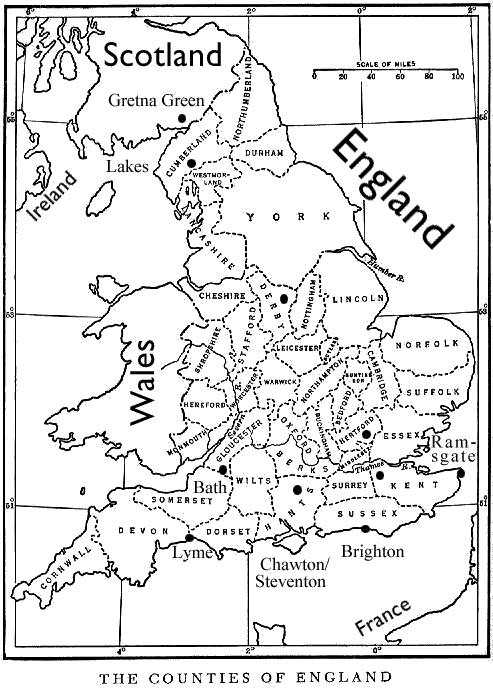
The Middle Class
The Regency Period - Austin's Time
Other Regency Authors
Jane Austen and Life
Itself
The Austen Novels
Jane Austen and Life Itself:
1775 Jane Austen born at village of Steventon, England, to George and Cassandra Austen.
1785-1787
With her sister, Cassandra, Austen attends the Abbey School in Reading, England.
1790-93
Writes her juvenilia.
1795-98
Writes original versions of Northanger Abbey, Sense and Sensibility, and Pride and Prejudice.
1797 "First Impressions" (original version of Pride and Prejudice) rejected by a London publisher.
1801 Father retires and moves to Bath with his wife and daughters.
1803 Susan (original version of Northanger Abbey) is bought by a publisher but never issued.
1804 Austen begins, and quickly abandons, "The Watsons."
1805 Death of father, George.
1808 Moves to Southampton with mother and sister.
1809-17 Lives with her mother and sister in a small house provided by her wealthy brother Edward in the village of Chawton, in southern England. Begins revising original versions of Sense and Sensibility and Pride and Prejudice.
1811 Sense and Sensibility published.
1813 Pride and Prejudice published.
1814 Mansfield Park published. Austen begins work on Emma.
1816 Emma is published and is dedicated to the Prince Regent (future George IV) at his request. Austen completes Persuasion.
1817 Composes the fragment "Sanditon"; abandons it because of incapacitating illness. Austen is moved to Winchester for medical care in May and dies there on 18 July. Buried in Winchester Cathedral on 24 July.
1818 Northanger Abbey and Persuasion published jointly in a four-volume edition, with a biographical preface of Austen by her brother Henry.
Longer
Version of Jane Austen's life.


The Austen Novels
 C. E. Brock illustrations for Pride and Prejudice
C. E. Brock illustrations for Pride and Prejudice
Sense and Sensibility
Published in 1811, this novel featured two sisters of varying temperaments, Elimore and
Marianne. At their father's death left without fortune, they are left to pursue love, loss and
life in their different manners.
Pride and Prejudice
This wonderful epic was published early 1813. A delightful mix of irony,
humor, and... of
course... romance, this is one of Jane Austen's most popular novels. Jane Austen described
this novel 'her own darling child', in a letter to her sister Cassandra, that was 'too light and
bright and sparkling; it wants shade; it wants to be stretched
out here and there with a
long chapter -- of sense if it could be had; if not, of solemn specious
nonsense -- about
something unconnected with the story; an essay on writing, a critique on Walter Scott, or
the history of Buonaparte, or anything that would for a contrast, and bring the reader with
increased delight to the playfulness and epigrammatism of the general style.'
' As 'Jane Austen: Her Complete Novels' so elegantly describes 'Pride and Prejudice' in it's introduction, this novel appeals to almost anyone who reads it. For a book to still be read by a wide audience well over a
century after it was originally published is an incredible feat. Such is the case of Jane
Austenís book, Pride and Prejudice, which though it was originally published in 1813, is still
popular to date, 1997. It is the irony, themes, characters and the entertaining aspects of this
charming book that keeps its relevance through the centuries.
Jane Austen uses irony to entertain the reader and to highlight the charactersí faults. This
is especially the case where Elizabeth is involved. In the beginning of the book Elizabeth,
who is proud of her judgment of character, is convinced of Mr Darcyís dislike, and bases
her opinion of him on this, although the reader knows this is not the case. This irony has
always been considered entertaining, despite the time differences, and is a tool that Jane
Austen uses in Pride and Prejudice without restraint.
In many of Jane Austenís novels she discusses many themes through the representations
of characters, situations and society. Pride and Prejudice is one of the greatest examples of
this. It is the themes that Jane Austen uses and the way she uses and portrays these
themes in the novel that makes Pride and Prejudice relevant to society today. The reason
for this is many of the themes are still being debated today, for instance feminism and the
level and form of education is needed. These issues are not presented as sermon, however,
but gently introduced in such a way that they create a more diverse story.
The characters of Pride and Prejudice are exaggerated in such a way that their faults
become obvious to the reader. Jane Austen uses this to play on the readerís feelings about
the characters. An example of this is Mr Collins she portrays as an extremely foolish man,
encouraging the readers dislike and disgust. Then she proceeds to play on the readerís
feeling about him so that he becomes so annoying that the reader cannot but laugh at him,
and feel sympathy towards Mrs Charlotte Collins. All the characters have been portrayed
in this way, including Lydia, Mrs Bennet, and Mr Bennet, although Jane Austen is
sometimes more subtle with some characters, Mr Darcy and Elizabeth in particular.
Despite the fact that there are many themes in Pride and Prejudice, it is important to
remember that Jane Austen wrote Pride and Prejudice to entertain not to use as a medium
to give a sermon to its readers. The themes give Jane Austenís opinion and are gently
given. Many books at the time where written mainly to tell people what to do. An example
of is ĎAdvice to Young Ladies on the Improvement of the Mind and Conduct of Lifeí,
which was published but three years before Pride and Prejudice. It is this purpose of the
book, to entertain, which still captures readerís attention today,'
Mansfield Park
Published in 1914, this novel features a rather dubious heroine of Fanny. Jane was writing
this while Pride and Prejudice was being received (with much acclaim) by the public; this
novel was released in May, and had sold out by autumn.
Emma
At the beginning of 1814, Jane began to write this brilliant novel; it was finished in March
1815 and published in 1816. The heroine, Emma, an heiress determined not to marry; 'I
shall not be a poor old maid; and it is poverty only which makes celibacy contemptible to a
generous public! A single woman, with a very narrow income, must be a ridiculous,
disagreeable old maid! The proper sport of boys and girls; but a single woman, of good
fortune, is always respectable, and may be as sensible and pleasant as anyone else.'
(Emma) However, she's forced to face some home truths after her melding with an easily
led (and poorer) friend backfires.
Northanger Abbey
Published in 1818 (posthumously), this novel -- a gothic satire -- was set mainly in Bath.
Provided by Miss Julia Smith: "Northanger Abbey is Jane Austen's masterful satire in
response to all of the overwrought gothic novels of the time. The novel Austen was chiefly
amused by was the Mysteries of Udolpho, by Ann Radcliffe. Many of the funniest scenes
in Northanger Abbey are take-offs on major scenes in that work. For example, when our
hapless heroine, Catherine, is searching through a chest of draws at the abbey, looking
for treasure map, or old journal, she finally discovers a mass of papers. Her excitement
mounting, Catherine begins reading eagerly-and finds no more than a laundry list.
More than just a satire, however, Northanger Abbey stands on its own as an excellent novel
about growing up and shedding the delusions of youth. Young Captain Tilney is a characterin the proud tradition of Henry Crawford and George Wickam. Isabella and John Thorpe
serve as examples to Catherine of what young ladies and gentlemen should not be; and
Henry Tilney emerges as a sort of young Mr. Knightley, loving Catherine despite her flaws,
and helping her get past them. Catherine herself should remind any reader of themselves;
she is naive, but eager to learn, mistake prone, but well-intentioned."
Persuasion
Published in 1818 (posthumously), this novel has a similar setting to Northanger Abbey --
Bath --, and was published at the same time. Seven years ago, Anne Elliot refused a
proposal by a Captain Wentworth, who she loves, because a trusted friend convinced he
was too far below her social station to make a match. Now, her beau re-enters her life.
Everything you need to know about Jane
Austen, links to all the texts, here.
Television
and Movie Versions of Austen Novels





